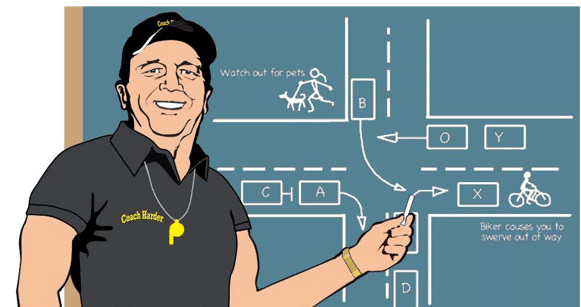TYPES OF LESSONS
Driving Lessons
The goal of each lesson is to build confidence and develop the skills necessary for our students to become safe, confident and responsible drivers. An individual lesson includes 90 minutes of private, one-on-one instruction, behind-the-wheel, with our late model vehicles that all have dual brakes and insurance. Lessons are individualized based on experience ranging from beginners who have never been behind the wheel to advanced including highway and parallel parking. Our instructors are all teachers, coaches, or officers.
We pick up and drop off from home, school, or work with many lessons beginning at school and ending at home. Instructors provide specific feedback at the end of each lesson explaining skills students should practice.
We offer a variety of drivers education packages that combine lessons at a discounted price and tailors our program to your family’s needs.
A valid permit or license is required for all driving lessons.

DMV Test Prep
The Test Prep lesson is designed to prepare advanced students for the driver exam. Our instructor meets the student at the testing center where they plan to take the exam. They spend 90 minutes practicing the tasks and maneuvers the officer will ask the student to complete. Practicing on the roads near the testing center familiarizes students with the area, so they are less anxious on test day. Our instructors will provide an honest assessment of the students’ safety awareness, ability to pass the road test and to drive independently.
Before testing, the State of Missouri requires 40 hours of practice driving time for students under 18 yrs and is recommended for all other pre-licensed drivers as well.

DMV Driver Exam
This service includes taking the driving exam in our vehicle and a one-hour review with one of our instructors prior to testing. At the testing center, our instructor will guide the student through the entire process ensuring minimal wait time and avoiding unnecessary confusion.
Our staff will book a road test appointment with the Missouri State Highway Patrol at the center of their choice, reducing the hassle of long lines and minimizing missed school or work. Please note that we cannot guarantee a passing grade.

The student’s driving skills need to be proficient to take the test. Missouri requires teens under 18 to have driven with a permit for at least 6 months and have logged at least 40 hours driving practice. While the immediate objective is to past the test, the ultimate goal is for all students to learn to be safe, confident and responsible drivers.
For everyone’s safety, we reserve the right to deny this service based on the instructor’s assessment of a student’s skills and abilities.

Online Classroom
The online classroom is a three hour introductory overview from police officers and our driving instructors. Topics include driving tips, vehicle controls, road signs, signals, and pavement markings, driving in different weather conditions, situational driving, driving distractions, and safe decision making. The online classroom is appropriate for students at any level of driving experience.
We develop a custom training regimen for each student covering skills such as:
BASIC SKILLS
Safety Controls
Know where each unique function of your car is from headlights, to emergency brake, to wipers and more.
Smooth Starts/Stops
Driving smoothly gives you better gas mileage, is easier on the vehicle, and is important for vehicle control.
Turning right while moving
One of the most important yet difficult maneuvers. You don’t want to swing out too wide, yet you also don’t want to over steer and hit the curb.
Turning left while moving
This is important because you might have to cross traffic in the process, you don’t want to turn too early and move into oncoming traffic lanes.
Turning right from a stop
The most difficult part of this is to not swing out too wide into oncoming traffic, while not hitting the curb at the same time.
Turning left from a stop
This is significant skill because of right of way rules must be known, observed and applied across cars and potentially multiple traffic lines.
Lane integrity
You don’t want to drive too close to one side or the other, as you go forward. This can be tricky when on curvy roads
Visual Scan
It is imperative you are able to drive and observe each side of the car, out the front of the car, and what is happening behind you.
INTERMEDIATE SKILLS
3 second following rule
Increasing the distance between you and the car in front of you can help give you the time you need to recognize a potential hazard and respond safely.
Road Signs
Signs serve a number of purposes such as bringing attention to speed limits, detours, construction work, hazards, steep hills, etc.
Speeds
Speeds are important in order to maintain control of the vehicle while driving at different levels of speed, over hills, and in different road conditions.
Signaling (100’ rule)
The 100’ signaling rule allows you to communicate your intentions so that other cars on the road are aware.
Identifying possible hazards
When driving, a hazard is something that forces you to change your speed or change your steering to avoid a collision.
Changing Lane properly
Changing lanes requires timing and attentiveness. You must look over your shoulder and check your blind spot, without losing lane integrity.
Roundabouts
Roundabouts reduced injury crashes by 75 percent at intersections where stop signs or signals were previously used, according to the IIHS.
Right turn yield (alley)
There are many intersections with a channelized right turn lane, where drivers turning right are separated by a small island through turning traffic.
90 Degree & Angle Parking
90 degree parking, or perpendicular car parking means parking the cars side by side, perpendicular to a wall, curb or something else.
Backing Out of a Space
Backing out of a space can be difficult because cars are often coming from both directions, while you are trying to get out of the space.
Curb/ Hill Parking
When you park alongside a curb the direction of your wheels is dependent on whether it’s uphill or downhill, and if there is a curb.
School Zones / Parks
School zone speed limits are important to observe while driving for the safety of students in the area.
ADVANCED SKILLS
Parallel Parking
Parallel parking gets a bad rap as a difficult maneuver but with the right training, breaking it into individual steps, it can be done quite easily in any sized vehicle.
Highway Driving
There are many key factors to highway driving; from merging, to awareness of others, to speed limit and merging on an off.
Rush Hour Driving
Between the volume of cars on the road, people rushing, and the stop and go movement of traffic, rush hour can be dangerous.
Bad Weather Driving
If you do get caught in bad weather, learn proper techniques of driving with snow, heavy rain, high winds, and sun.
Backing a straight line
It is important to understand where to look, and how to manipulate the car so that you can get from point A to B safely.
2 and 4 way stops
Stopping smoothly, understanding right of way and when it is your turn to go is important at these intersections.
Left turn center yield lane
Many two-way streets have a center lane marked as a two-way left turn lane. This lane is for the exclusive use of left turning vehicles.
Emergency Situations
What to do in if emergency vehicles are on the road you are driving.
